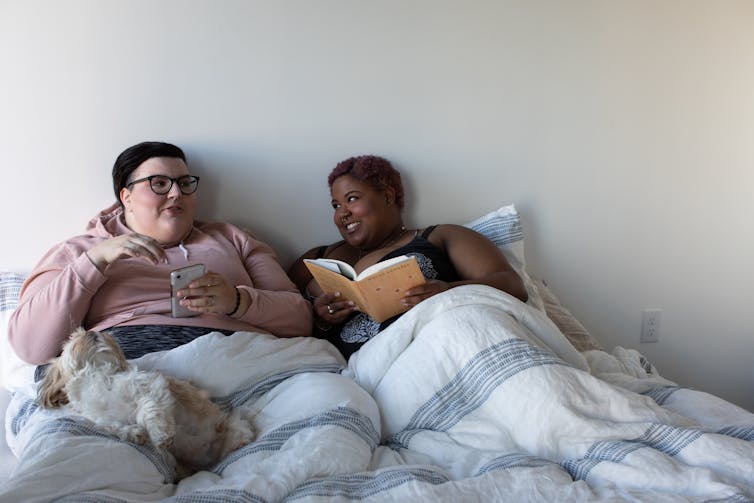Canadians are having less sex, not more, during the coronavirus pandemic

Yuliya Rackal, University of Toronto
Flexibility is the ability to bend without breaking. If we are all trees amidst a pandemic storm, the windy gusts of virus variants and vaccine delays are blowing our branches, hard. It’s been nearly a year now and many of us feel like we are going to snap: It’s bend or break time.
Are we sheltering the storm by slipping under the sheets with a significant other? Surprisingly, no.
The naked truth is that Canadians are having less sex, not more, according to a national survey by researchers at the University of British Columbia. Reasons for this decrease could include increased mental health problems, too much time together for couples or too much time alone for singles.
It’s an unfortunate twist, because we need this type of feel-good activity when stress is at an all-time high. Research has consistently found that more frequent intimate sexual encounters are associated with greater well-being. Regardless of their personal situation, improving sexual flexibility may be just what Canadians need to perk up their drooping sex lives.

Measuring sexual flexibility
Stéphanie Gauvin, a doctoral student in psychology at Queen’s University, created a measure of such flexibility, which she named the SexFlex Scale:
A sexual script is like a sexual menu. When you go to have a sexual interaction with someone, you have this menu of options that you can select from. Some will have a bigger menu because they have more things they have thought of, and some have a more exclusive menu. With your partner, you have to figure out the pieces of that menu you might want. There may be menu items that are your go-to favourites, some that you are willing to try, or some you’re not really sure about, but might be willing to try.
But what if an ingredient isn’t available or there is a new chef? Detours in sexual scripts could present as differences in desire between partners due to factors including pain, performance anxiety, arousal difficulties, medical conditions or times of transition like menopause.
How easily one can change their approach, modify strategies for sex or think of different options to suit changing sexual situations are components of the SexFlex scale.
Gauvin likens low sexual flexibility to insistence around restaurant dining.
“I need to have a three-course meal, with soup or salad as the first course, the main has to have meat and I must have chocolate cake for dessert! If there is no chocolate cake, we didn’t even go out for dinner.”
Individuals able to try alternate strategies to preferred sexual scripts are thought to cope better with acute and chronic sexual issues. In their study of post-prostate cancer patients, University of New Brunswick researchers found most men had fairly narrow and traditional sexual scripts that required penile-vaginal intercourse.
Erectile dysfunction was often seen as the end of their sex life and many chose to discontinue all sexual activity, even when their desire for sex was still intact. The findings from another study on sex after prostate cancer epitomizes the importance of sexual script flexibility in improving sexual satisfaction for self and a potential partner: “If you’ve got 10 fingers and a tongue, sex ain’t dead.”

Desire and motivation
Motivation is also critical. The distinction between a sensory experience that mutually gratifies both partners and sex to accommodate the desires of just one is important. Engaging in sex to avoid conflict or disappointment is associated with lower relationship and sexual satisfaction. Unsurprisingly, sex that enhances intimacy or promotes closeness with a partner has the opposite outcome.
Caroline Pukall, clinical psychologist and head of the Sex Research Lab at Queen’s University, helps clients reframe sexual encounters with an approach focus: “Can we talk about sexual pleasure or intimacy as a goal?”
Back to the food metaphors. Sex doesn’t always have to mean setting the broiler on high. Start by “simmering with your sexuality,” suggests Pukall. This is especially important for those with a history of trauma or medical issues. Taking bubble baths together or simply spooning naked in bed would be examples.
Those seeking to expand their sexual menu but don’t know how to start, need to begin with a (probably uncomfortable) conversation about sexuality. But sexual self-disclosure, discussing sexual likes and dislikes, can produce a menu that is consensual and mutually pleasurable.
And as always nowadays, there are apps — like Mojo — that are useful for helping to add sexual novelties. New flavours that, with ongoing discussion and consent, could spice up the menu. For those with vulvas, OMGYes! is recommended by sexperts for understanding more about what makes you feel good.
Sexual scripts
To preserve our dining metaphor, one could ask: “Who sets the menu in the first place?”
There is evidence that those adapting their sexual lives in creative ways are thriving despite the swirling pandemic storm. The Kinsey Institute at Indiana University surveyed 1,559 adults — 70 per cent female and 75 per cent American — and found that while nearly half reported a decline in their sex life, those expanding their sexual repertoire by including new activities such as sexting, trying new sexual positions or sharing sexual fantasies were three times more likely to see their sex life improve.
Kim Tallbear, an associate professor of Native Studies at the University of Alberta is one of the producers of Tipi Confessions, a creative storytelling show on sex, sexuality and gender with Indigenous, feminist, queer and educational perspectives. Her critical lens on decolonizing sexuality challenges us to consider that love and care can be enlarged, not compromised or lost, when we embrace a multiplicity of relations.
Don’t be spoon-fed — discover your own unique personal tastes and take some time to plan out a solo or partnered sexual menu — and enjoy.![]()
Yuliya Rackal, Assistant Professor Department of Family and Community Medicine, University of Toronto
This article is republished from The Conversation under a Creative Commons license. Read the original article.

